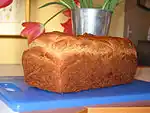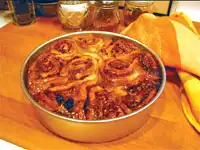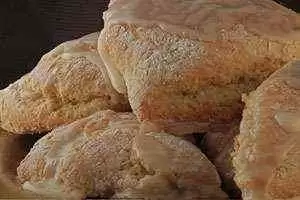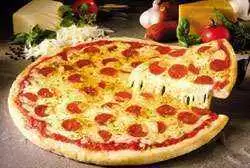
Gluten-free bread making the first few times is an incredibly frustrating experience that begs the question...is it really worth it? After my many trials I must say yes it is definitely worth it! We are now able to make an excellent bread that we can all enjoy. Being able to make bread allows my kids to take a sandwich to school, the fact that the bread is good (and looks good) is equally important to them. Since they cannot eat the hot lunch at school due to its "gluten in every bite" nature, it is important to have the option of sending a sandwich the children like (and will eat). Other kids taste the bread, they like it, and say hey this gluten-free diet is pretty good! The benefits to these exchanges are priceless.
It took awhile to get to this point but one day I was lucky enough to meet Lee Tobin. He gave me a recipe (originally developed by Barbara Emch) and I had success! I then began to shape this recipe to accommodate the various alternative flours stocked in my pantry. The recipe is fool-proof and it tastes great...especially with teff, amaranth, or buckwheat flour.
Celiac.com Sponsor (A12):
In this class you will learn how to make a perfect loaf of bread. I will review alternative flours and why I use them. You will learn the tricks for successful gluten-free bread making. And you will learn how to change the template recipe for your own specific needs.
In an effort to provide you with a brief recipe for future use—all of the comments I would typically make during a cooking class will be found in the text that precedes the recipe.
Why Use Alternative Flours?
My experience has been that these flours simply make a superior gluten-free bread. Additionally, many celiacs struggle with weight gain after diagnosis and find their diet may lack important nutrients. As you adjust to the gluten-free diet it is a good time to understand how your body uses the food you eat.
Simple carbohydrates are quickly digested and are broken down into simple sugar glucose. When the cells in your body need fuel they use this glucose. Extra glucose is converted into glycogen. If your body already has enough glycogen stored up, the glucose is turned into fat. The typical American diet is overloaded with simple carbs and the celiac diet is no exception.
Complex carbohydrates not only take longer to digest but they provide slow consistent energy. You feel full longer and your body doesnt feel the wide fluctuations of blood sugar swings. Beans, whole grains, nut butters, oatmeal, soy, sweet potatoes, and vegetables are complex carbs. They provide needed vitamins, minerals, fiber, and consistent energy. Many celiacs lack B vitamins, calcium, iron, and other nutrients—why not get them from your baked goods and reap the benefits of complex carbs?
We try to incorporate the alternative flours in most of our baking. When making sweet breads, cookies, bread, pizza crust, biscuits, and bread sticks I try to substitute about ½ of the flour called for in a recipe with a healthy alternative flour. Our favorites are teff, amaranth, brown rice, and buckwheat. Quinoa and millet flours can be substituted in the same fashion. Be sure you buy from manufacturers who provide pure, gluten-free flour—from the field all the way to the package.
In our family we treat corn, carrots, potatoes, and white rice as if they were sweets (i.e. sugar = excess weight gain). They are all simple carbs as are most of the products made from them (chips, cereal, snacks).
Here is a quick overview of the various healthy gluten-free flours and their attributes:
Amaranth is a whole grain dating back to the time of the Aztecs. It is high in protein (15-18%), and contains more calcium, folic acid, Vitamin A, C, and E than most grains. The flavor is similar to that of graham crackers without the sweetness.
Bean Flour is a light flour made from garbanzo and broad beans. When using this flour in your favorite recipes, replace the white sugar with brown or maple sugar (or combine with sorghum) to cut the bitter taste of the beans.
Brown Rice Flour is milled from unpolished brown rice, and has a higher nutrient value than white rice flour. Since this flour contains bran, it has a shorter shelf life and should be refrigerated. As with white rice flour, it is best to combine brown rice flour with several other flours to avoid the grainy texture. Much higher than white rice in protein, fiber, zinc, folic acid, B vitamins, calcium and vitamin E (15 times the E in white rice).
Buckwheat is the seed of a plant related to rhubarb. It is high in fiber, iron, and B vitamins. Great in many baked goods, pancakes & waffles too.
Millet is a small round grain that is a major food source in Asia, North Africa, and India. A rich source of B vitamins.
Nut Flours are high in protein and, used in small portions, enhance the taste of many baked goods. Finely ground nuts added to a recipe increases the protein content and allows for a better rise. It is a great substitute for non-fat dry milk powder in gluten-free recipes. We like it so much we always make the substitution. Keep refrigerated.
Quinoa (keen-wah), a staple food of the Incas, is a complete protein containing all 8 amino acids as well as a fair amount of calcium and iron. High in some B vitamins and folic acid.
Soy Flour has a nutty flavor, and is high in protein and fat. Best when used in small quantities in combination with other flours. Soy flour has a short shelf life.
Teff is an ancient grain from Ethiopia, now grown in Idaho. It is always manufactured as a whole grain flour, since it is difficult to sift or separate. A good source of protein, calcium, iron, fiber, and B vitamins.
Cross-contamination at the factory can cause diet compliance issues for the gluten intolerant. Call or write the manufacturers of your preferred flours to inquire about factory and field practices.
Many people may wonder why I use just one recipe for bread. It is really a template that can be changed to suit your own tastes, preferences, or dietary needs.
Changeable elements in the recipe:
Eggs
One of the most challenging substitutions, if you cannot tolerate eggs use Egg Replacer from Ener-G Foods (or try ground flax seeds as an egg replacement see recipe in flax seed section below) and be sure to use the almond flour instead of the non-fat, dry milk powder. The almond flour adds a great deal of flavor which could be helpful when you cant use eggs. If you read the nutritional label for almond flour it might scare you as the grams of fat are high, remember this is good fat and there is fiber-- both of which slow down sugar absorption in your body, which in turn helps control weight gain. The dry milk powder is high in sugar.
Oil
Vegetable oil is typically soybean oil and some people are sensitive to canola oil so safflower oil is a good alternative.
Sugar
I want to experiment with different forms of sugar to find a healthier alternative to the white refined sugar I use presently. Try turbinado sugar, a raw sugar that has been steam-cleaned. It has a delicate molasses flavor.
Flour
Four cups of flour are in the recipe. The proportions of flours used can be changed around until you find what is right for you. We use it in the way shown in the recipe but my goal is to experiment further and reduce the amount of tapioca flour and increase the healthier flours.
Dry milk powder
As seen above in the eggs section I now prefer to use almond flour instead of dry milk powder. The bread is much more flavorful and has a wonderful texture.
Flax seed
This seed has many health benefits such as high-quality protein, fiber, B and C vitamins, iron, and zinc, anti-cancer properties, omega-3 fatty acids, and many other benefits. To use as an egg substitute grind 2 tablespoons flaxseed and add 6 tablespoons boiling water, let set for 15 minutes then whisk with a fork-- this mixture will replace 2 eggs in a recipe. A clean coffee grinder works well to grind the small flaxseed.
Cookware
Its a good idea to have the proper cookware in your kitchen before attempting to make gluten-free bread. You must have a heavy-duty stand mixer like the Kitchenaid mixer. A heavy-duty mixer properly aerates the batter producing a lighter bread with a fine crumb and more height. You should also have a good quality loaf pan. It helps to know if your oven is running at the correct temperature (an inexpensive oven thermometer will tell you what adjustments you will need to make).
Bread machines can be tricky with gluten-free bread, you can call the Celiac Hotline at Red Star Yeast for the most current bread machine recommendations 1.800.423.5422.
Temperature
In addition to knowing your oven temperature, realize that when the temperature of your home is warm, bread will rise quicker. The recipe includes some tricks to help your bread rise faster when your home is cool (as is generally the case in Seattle).
Humidity
Gluten-free flour absorbs moisture from the air so be sure to keep it sealed in its packaging and tightly cover any mixing bowls rather than allowing them to sit uncovered for any period of time. The moisture the flour absorbs from the air will affect your recipe.
Amaranth Bread:
Amaranth Bread makes one loaf. Feel free to substitute the amaranth flour with teff, buckwheat, or quinoa flour.
Ingredients
3 large eggs (egg-free option see note below)*
¼ cup vegetable oil
1 teaspoon lemon juice
1½ cups amaranth flour
1½ cups tapioca starch flour
1 cup fine brown rice flour
2/3 cup instant non-fat dry milk powder (dairy-free: substitute with finely ground nuts or almond flour)
2 teaspoons xanthan gum
1 teaspoon salt
2 tablespoons ground flax seed (optional)
1½ tablespoons active dry yeast
4 tablespoons sugar
1¼ cups warm water (105F-115F.)
Bring all refrigerated ingredients to room temperature. Grease a 5 x 9-inch loaf pan.
In the bowl of a stand mixer, combine eggs, oil, and lemon juice. In a separate medium bowl, combine flours, dry milk powder, xanthan gum, salt, flax seed, yeast and sugar. Pour ½ of the warm water into stand mixer and blend with egg mixture. Slowly add dry ingredients a little at a time until completely incorporated. Add remaining water, reserving some water if necessary. See note on humidity below. Mix batter on high speed for 3½ minutes, then pour into prepared pan. Batter will be thicker than a cake batter and nothing like the consistency of regular bread dough.
Cover bread with foil and place in a cold oven. Set a pan of hot water on a lower shelf underneath the bread. Leave for 10 minutes with oven door closed. (This will cause the bread to rise quickly.) Remove bread from oven (do not uncover) and place in a warm place in the kitchen. Preheat oven to 400F. Bread will continue to rise as oven preheats.
Uncover bread and bake for 10 minutes to brown the top. Cover bread with foil and continue to bake bread for 35-40 minutes. Turn bread out onto a cooling rack. When completely cooled, wrap tightly to maintain freshness for as long as possible.
Tips:
- If humidity is high, reduce the amount of water in the recipe to avoid over rising. Many gluten-free bakers experience the frustrating situation in which a beautiful loaf of bread deflates once removed from the oven. You will need to experiment a little to get just the right amount of water in your bread depending on the humidity in the air. If in question, use less water than the recipe calls for.
- You may use rapid rise yeast instead of regular yeast. If doing so, eliminate the cold oven rise method with a pan of hot water, follow yeast package directions instead for rise time.
Hamburger Buns
Pour batter into English muffin rings, follow directions above. Bake for just 15 minutes.
Once completely cooled these buns freeze well. Serve buns warmed, otherwise they will be crumbly.
*Egg Substitution: grind 3 tablespoons flaxseed and add ½ cup + 1 tablespoon boiling water, let set for 15 minutes then whisk with a fork.
Recipes from:
Cooking Gluten-Free! A Food Lovers Collection of Chef and Family Recipes Without Gluten or Wheat
Karen Robertson (Celiac Publishing, 2002)











Recommended Comments